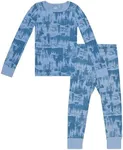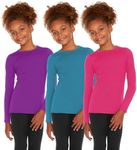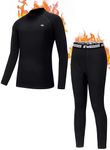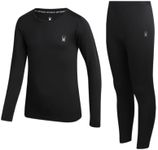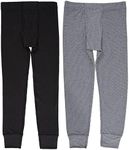Buying Guide for the Best Kids Thermal Underwear
When it comes to picking the right thermal underwear for kids, it's important to focus on comfort, warmth, and durability. Kids are active and need clothing that can keep up with their energy levels while providing the necessary insulation during colder months. The right thermal underwear will keep them warm without causing overheating or discomfort. Here are some key specifications to consider when choosing kids' thermal underwear.MaterialThe material of thermal underwear is crucial because it determines the warmth, comfort, and breathability of the garment. Common materials include cotton, wool, and synthetic fibers like polyester or blends. Cotton is soft and comfortable but may not provide the best insulation when wet. Wool is excellent for warmth and moisture-wicking but can be itchy for some kids. Synthetic fibers are great for moisture management and durability. Choose a material based on your child's comfort preferences and the level of activity they will be engaging in.
FitThe fit of thermal underwear is important for both comfort and effectiveness. A snug fit ensures that the underwear can trap body heat effectively, but it shouldn't be too tight to restrict movement or cause discomfort. Look for options that offer a good balance between snugness and flexibility. For very active kids, consider thermal underwear with some stretch to accommodate their movements.
WeightThermal underwear comes in different weights, typically categorized as lightweight, midweight, and heavyweight. Lightweight thermals are suitable for mild cold and high activity levels, as they provide some warmth without causing overheating. Midweight thermals offer a balance of warmth and breathability, making them versatile for various conditions. Heavyweight thermals are best for very cold conditions and less active situations. Choose the weight based on the climate and the level of activity your child will be involved in.
Moisture-WickingMoisture-wicking properties are important to keep kids dry and comfortable. This feature helps to draw sweat away from the skin, preventing chills and discomfort. Synthetic materials and wool typically have good moisture-wicking abilities. If your child is very active or will be wearing the thermals for extended periods, prioritize moisture-wicking properties to ensure they stay dry and warm.
Seam ConstructionThe construction of seams in thermal underwear can affect comfort, especially for kids with sensitive skin. Flatlock seams are designed to lie flat against the skin, reducing the risk of chafing and irritation. Check the seam construction to ensure it won't cause discomfort during wear. For kids who are particularly sensitive, seamless options might be the best choice.
Layering CompatibilityThermal underwear is often used as a base layer, so it's important that it works well with other layers of clothing. Look for thermals that are thin enough to be worn comfortably under regular clothes without adding bulk. This ensures that your child can stay warm without feeling restricted by too many layers. Consider the overall wardrobe and how the thermal underwear will fit into it.
Ease of CareKids' clothing needs to be easy to care for, and thermal underwear is no exception. Check the care instructions to ensure that the thermals can be machine washed and dried without losing their shape or effectiveness. Materials like synthetic fibers and wool blends often require specific care, so choose options that fit your laundry routine to maintain the longevity of the garment.





